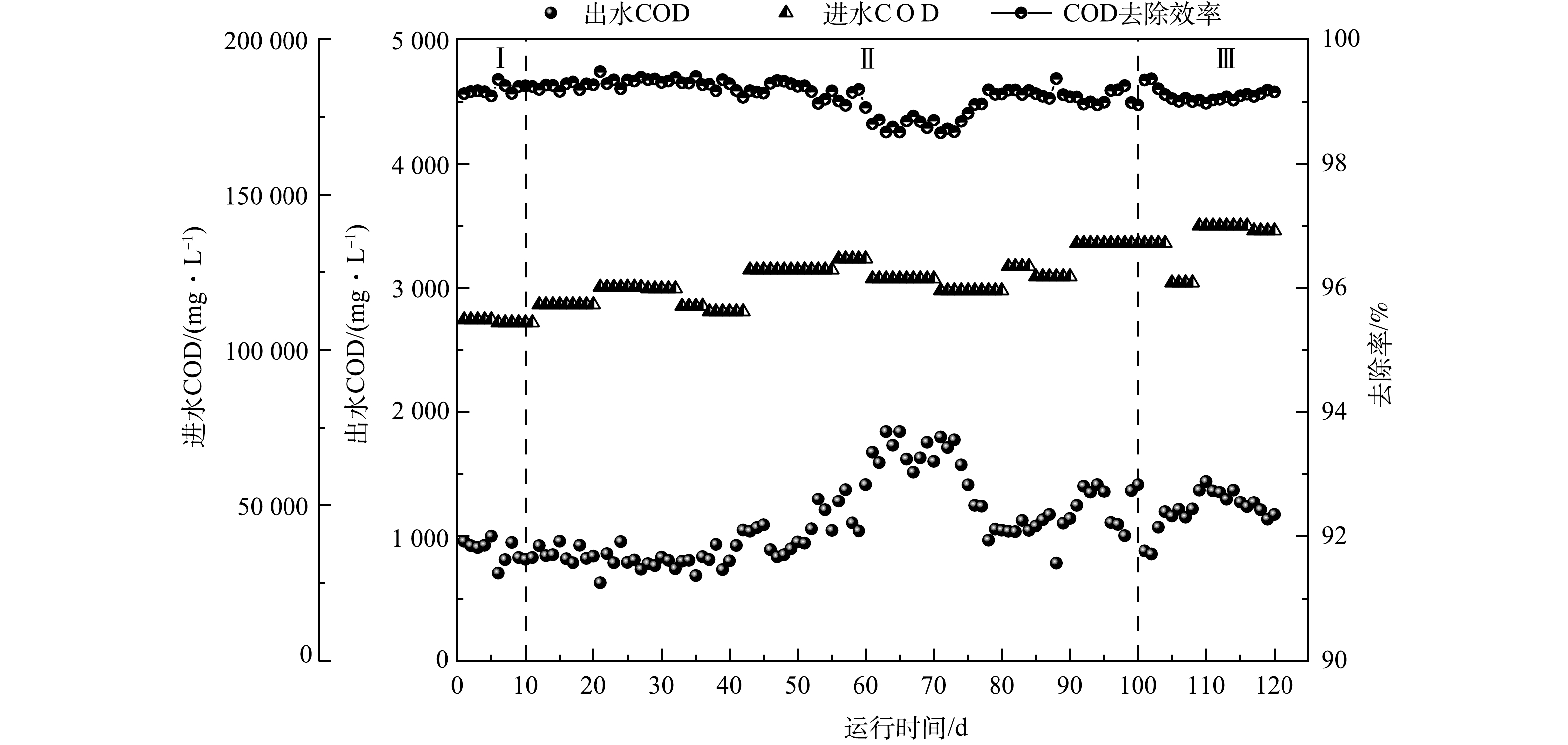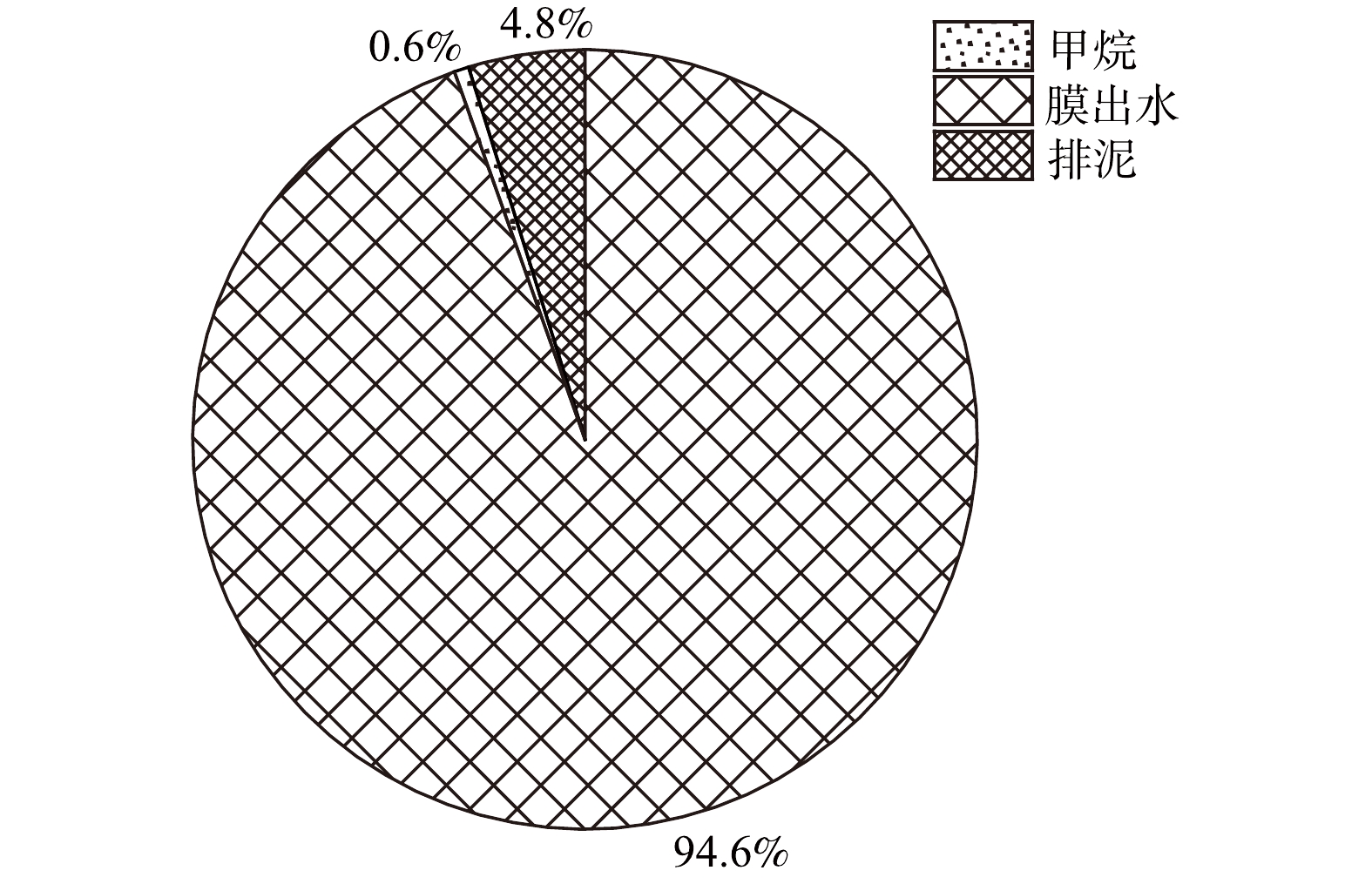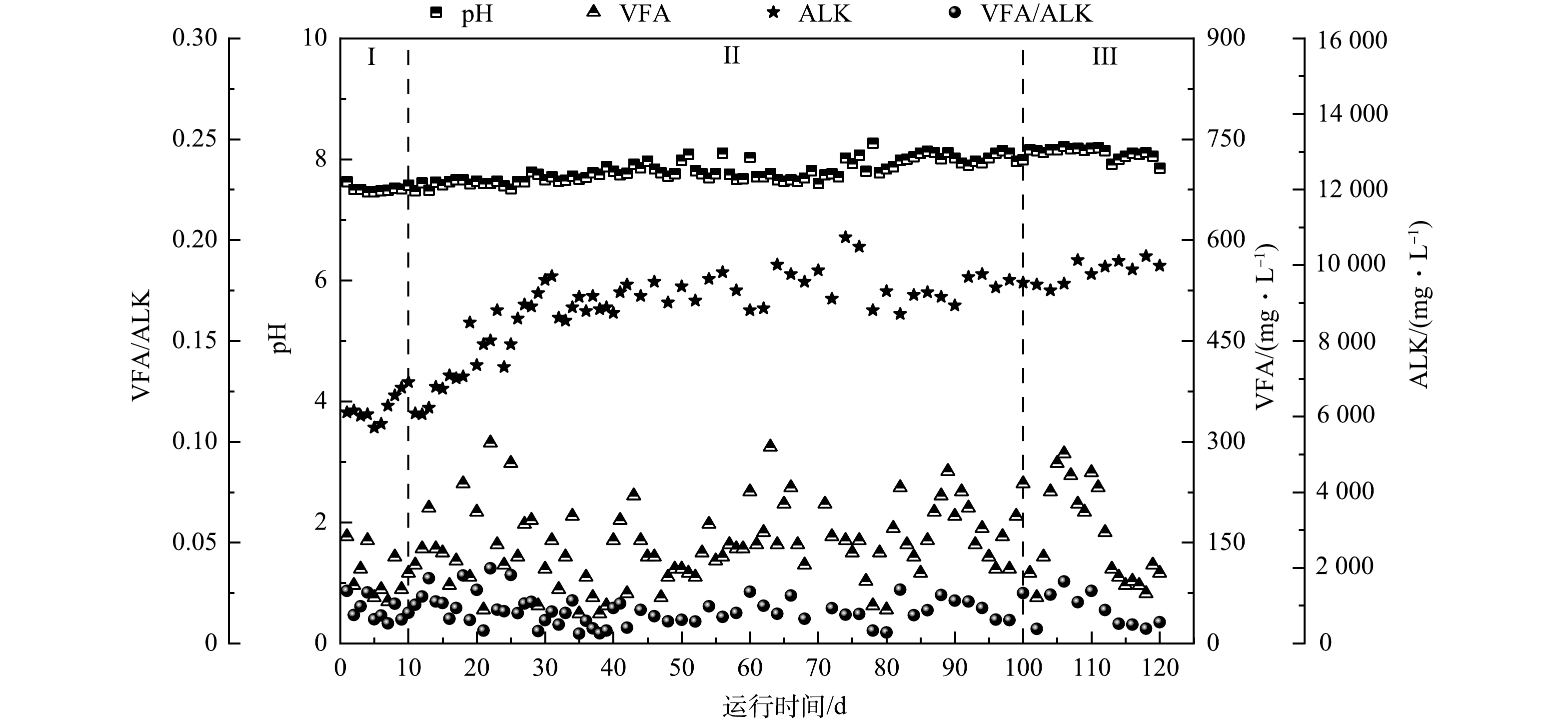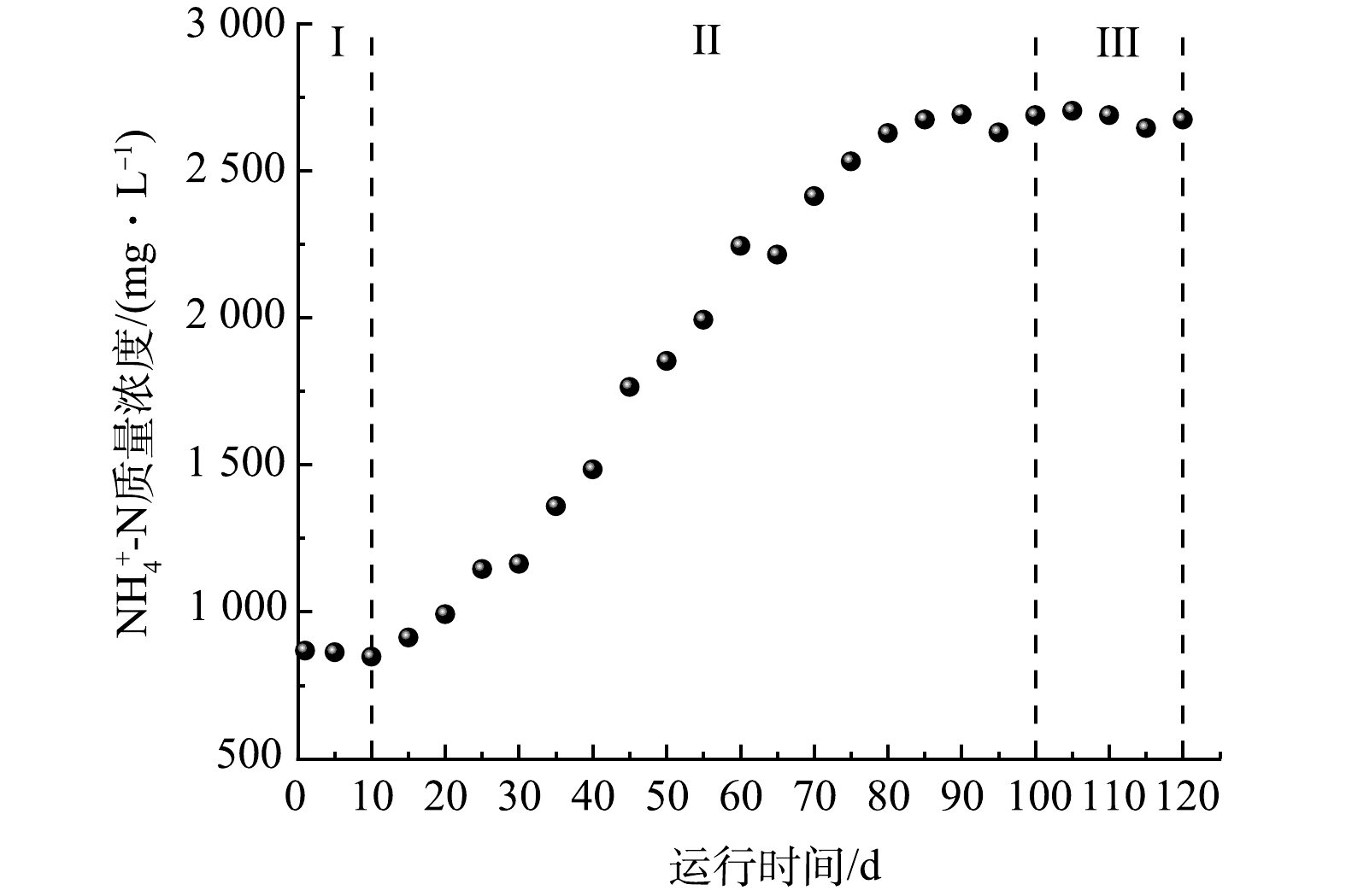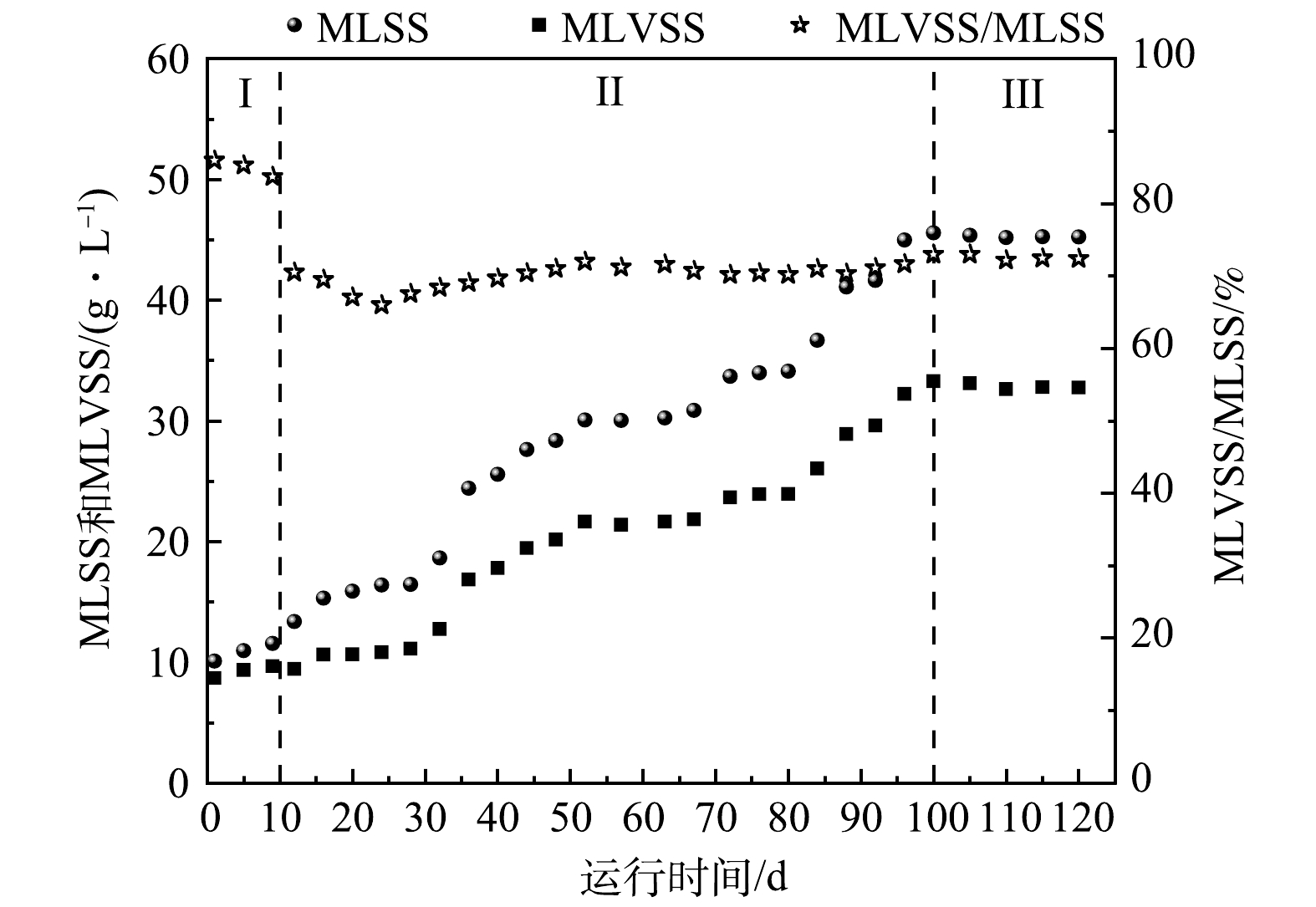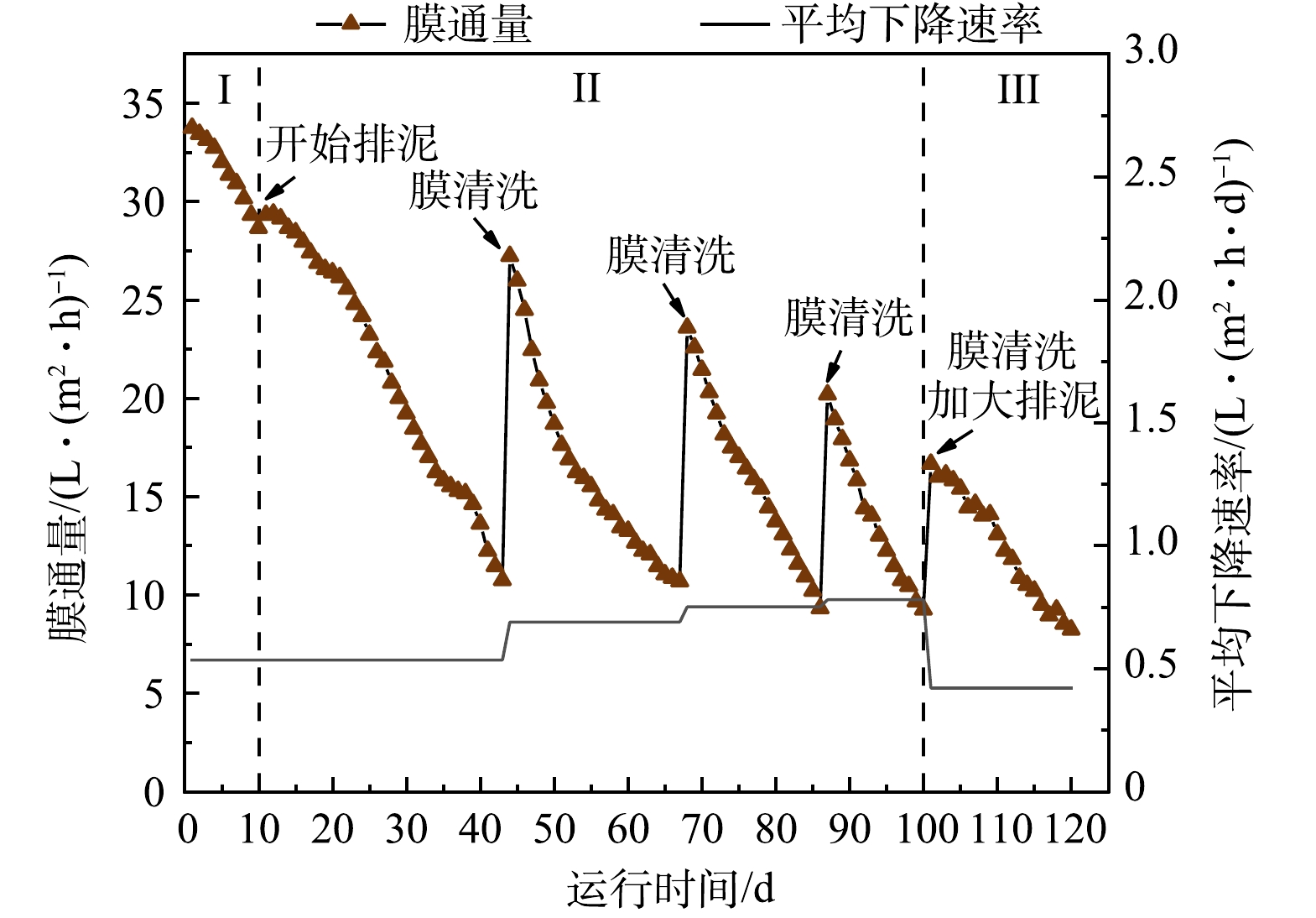-
据国家统计局发布数据显示,2020年我国整体的餐厨垃圾产生总量达到12 775万t[1]。从化学成分来看,餐厨垃圾主要由淀粉、纤维素、脂类、粗蛋白质、有机酸、无机盐以及一些Ca、Mg、Fe、K等微量元素组成[2]。餐厨垃圾经过分离破碎、高温蒸煮、油提取和固液分离后,形成高油、高盐、高氮及高有机物的餐厨废水[3],是餐厨垃圾处理的难点。根据文献报道[4],餐厨废水化学需氧量(chemical oxygen demand,COD)、氨氮和总氮质量浓度可分别达到100 000、300和2 000 mg·L−1。这使餐厨废水成为水质富营养化的重要污染源头,如处置不当,会引发一系列环境卫生、食品安全和人体健康问题。目前,处理餐厨废水主要采用的处理方法为全混式厌氧消化(continuous stirred tank reactor, CSTR)+好氧生物处理,然而由于餐厨废水的复杂性,CSTR在其处理工程中遇到污泥上浮或流失、泥水分离困难、微生物流失严重、产甲烷能力受抑制等诸多问题,从而导致挥发性脂肪酸累积、处理负荷下降、处理效率降低等问题[5]。此外,厌氧出水在后续好氧生化处理过程中,由于碳氮比失调需要投加大量的碳源,厌氧出水带泥也给好氧生化带来巨大的压力。因此,探索新型高效的餐厨废水处理方法迫在眉睫。
近年来厌氧膜生物反应器(anaerobic membrane bioreactor, AnMBR)逐渐引起人们广泛关注。AnMBR是一种将厌氧生物处理单元和膜分离技术有机结合的新型废水处理工艺,既保留了厌氧技术的诸多优点,膜组件的引入又可以完全截留微生物,实现污泥停留时间(sludge retention time, SRT)和水力停留时间(hydraulic retention time, HRT)的有效分离,又利于厌氧菌的富集,提高系统的生物降解效率[6-7]。在我们以往的研究中发现AnMBR的出水具有低COD和低COD/N的特征,在不额外投加碳源情况下,传统的硝化反硝化工艺难以实现高效脱氮,而部分亚硝化/厌氧氨氧化是基于两种自养菌(氨氧化菌和厌氧氨氧化菌)的新型污水脱氮工艺,适于处理低COD、低COD/N的厌氧工艺出水[8],可节约至少60%的曝气量,且具有自养脱氮过程无需外加碳源、剩余污泥量少等优势。然而厌氧氨氧化菌生长缓慢、生存温度范围窄、难以富集等因素造成该过程对反应条件十分敏感,特别是高浓度有机物存在的情况下,会严重影响甚至抑制厌氧氨氧化菌的活性[9]。因此,在AnMBR处理餐厨废水的工艺中既要保证运行负荷,又要提高处理效率,降低出水COD,从而减少其对厌氧氨氧化菌的抑制。CHENG等[10]开展了中空纤维型厌氧膜生物反应器和全混合厌氧反应器处理配制的低油脂餐厨废水的小试研究,指出厌氧膜生物反应器在有机负荷为9.72 kg·(m3·d)−1时生物气产量和有机物的去除效率均处于较高的水平并且优于全混合厌氧反应器。曹琦等[11]研究了中温条件下外置式厌氧膜生物反应器处理模拟餐厨废水的效能,结果表明,有机负荷为15 kg·(m3·d)−1时,各物质去除效果、产气效果以及系统运行的稳定性均处于最佳状态:出水COD保持在1 000 mg·L−1以下,COD去除率达到90%以上,日平均产气量为177 L·d−1。由此可见,AnMBR工艺在处理餐厨废水方面具有较好的可行性,且其出水水质适用于部分亚硝化/厌氧氨氧化工艺。
然而,当前大多数学者仅针对AnMBR处理模拟餐厨废水的运行效果进行了实验室规模的小试研究,关于其在实际高浓度餐厨废水处理的研究和工程应用则较少。为此,本研究通过构建中试规模AnMBR,处理张家港市某餐厨垃圾处理厂餐厨废水,重点研究了缓慢阶段提负荷下AnMBR的厌氧消化性能、厌氧稳定性能、污泥性质以及膜性能的变化,分析了其内在的相互关系及可能原因,以期为工业化应用提供参考。
-
本实验装置为中试规模的厌氧膜生物反应器(AnMBR),其结构及流程如图1所示。该系统主要由两部分组成:厌氧反应单元和膜单元。厌氧反应单元包括进水装置、主体厌氧罐、温控系统及在线监测系统等。进水装置是采用蠕动泵来实现均匀进水。主体厌氧罐有效工作容积为40 L,通过自动加热装置、自动冷却装置及温度控制系统将厌氧罐温度维持在(39±1) ℃。膜单元主要由膜组件和循环泵组成,该膜组件采用外置管式超滤膜,膜材质为聚偏氟乙烯PVDF(MEMOS,德国),总膜面积为0.08 m2,截留分子质量为100 kDa。循环泵的功率为1.1 kW,流量为2 m3·h−1。
-
本研究中厌氧膜生物反应器的接种污泥取自张家港市某餐厨垃圾处理厂内处理餐厨废水的厌氧絮状污泥,其本身对餐厨废水有较好的适应能力。接种污泥的MLSS为10.11 g·L−1,MLVSS/MLSS为0.85,接种量为40 L。
-
本实验中所用餐厨废水为张家港市某餐厨垃圾处理工厂内餐厨垃圾经过高温蒸煮、三相分离工艺后得到的餐厨废水,其具体性质如下:COD为(121 470±12 930) mg·L−1,NH4+-N为(325±45) mg·L−1,pH为3.6±0.3,电导率为(10.9±2.3) ms·cm−1,脂肪为(5.9±0.3) g·L−1。该餐厨废水含有高浓度有机质及悬浮固体,MLSS为19.32 g·L−1,为浆状。
-
如表1所示,AnMBR分为3个运行阶段:第Ⅰ阶段(0~10 d,污泥驯化阶段),保持低负荷(1.5 kg·(m3·d)−1)运行,每天监测出水水质和产气变化,体系正常产气、出水水质良好标志着污泥驯化的初步完成。第Ⅱ阶段(11~100 d,容积负荷(VLR)提升阶段),每天排泥0.4 L以控制SRT=100 d,缓慢阶段提高容积负荷,反应器在进水负荷3.0、4.5、6.0、7.5、9.0、10.5和12.0 kg·(m3·d)−1下各运行了10 d,随后为了保证出水水质良好,最终稳定在12.0 kg·(m3·d)−1的负荷下持续运行,考察容积负荷提升过程中反应器运行性能变化。第Ⅲ阶段(100~120 d,污泥停留时间(SRT)缩短阶段),保持容积负荷为12.0 kg·(m3·d)−1,每日排泥由0.4 L增加到1 L以控制SRT=40 d,考察运行性能和膜污染减缓情况。
-
COD、氨氮、VFAs、碱度(alkalinity, ALK)、MLSS和MLVSS测定根据《国家水和废水监测分析方法》[12]。其中COD采用重铬酸钾法测定,用硫酸汞掩蔽Cl−;氨氮采用纳氏试剂法进行测定;VFAs采用总量比色法测定;ALK采用电位滴定法测定,以CaCO3计;MLSS、MLVSS采用105 ℃烘箱烘干法和600 ℃马弗炉灼烧法测定。pH采用玻璃电极法测定;沼气产量采用湿式气体流量计测定;甲烷含量采用便携红外沼气分析仪(Gasboard-3200 Plus,湖北锐意自控系统有限公司制)测定。
-
1)容积负荷与沼气产量、甲烷产率变化情况。本研究所使用的餐厨废水中有机质浓度很高,COD高达100 g·L−1,通过厌氧消化可以将其中有机质转化成CH4,从而实现能源的高效回收,具有重要的经济价值[13]。为此,监测了AnMBR在不同运行阶段下的产气变化情况,结果如图2所示。第Ⅰ阶段为污泥驯化阶段,采取低负荷启动方式,控制进水量保持反应器的容积负荷稳定在1.5 kg·(m3·d)−1。该阶段沼气产量平均在30 L·d−1,甲烷含量由47%逐渐升高到56%,甲烷产率在10 d内由227 mL·g−1(以COD计)升高至267 mL·g−1,完成了快速启动。分析其原因可能为,膜的截留作用使污泥完全截留在体系内,无限长的SRT有利于产甲烷菌的生长和富集,因此,在较短时间内可以实现反应器的快速启动[14]。此外,理论上在标准状态下还原1 gCOD产生0.35 L甲烷[15],然而第Ⅰ阶段甲烷产率并未达到理论值,可能为该阶段反应器处于初步启动过程,产甲烷菌并未完全激活,因此甲烷产率低于标态下的350 mL·g−1。
随后进入第Ⅱ阶段(10~100 d),此阶段控制SRT=100 d,缓慢阶段提高负荷,容积负荷由3.0 kg·(m3·d)−1逐步提升至12.0 kg·(m3·d)−1,提升梯度为1.5 kg·(m3·d)−1,并在每一容积负荷情况下各运行10 d。随着容积负荷由3.0 kg·(m3·d)−1提升至12.0 kg·(m3·d)−1,平均沼气产量由63 L·d−1逐步提高至270 L·d−1,甲烷产率也逐渐由283 mL·g−1升高并稳定至335 mL·g−1左右,接近理论甲烷产率350 mL·g−1[15]。期间除了60~65 d(容积负荷为10.5 kg·(m3·d)−1)时反应器沼气产量因受负荷冲击影响而没有呈现增加趋势、甲烷产率出现过短暂轻微下降随后迅速恢复以外,其余时间反应器的沼气产量和甲烷产率均未受到影响,系统的产气效果良好,说明在负荷提升过程中,产甲烷菌活性并没有显著受到负荷提升的影响,相反的其在负荷提升过程中得到激活,产甲烷性能得到提升。膜的截留使得反应器内微生物量得到快速提升,不断提升的负荷也为微生物提供了营养物质,激发了微生物活性[16]。
随着反应器不断运行,污泥浓度逐渐升高,导致膜通量衰减严重,因此第Ⅲ阶段加大排泥量尝试缓解膜污染,排泥由0.4 L增加到1L以控制SRT=40 d,并保持容积负荷12.0 kg·(m3·d)−1运行20 d。在此期间沼气产量和甲烷产率相较于第Ⅱ阶段末期无明显变化,所对应的平均值分别为271 L·d−1和335 mL·g−1。可以看出加大排泥量尽管会导致污泥浓度降低,但沼气产量和甲烷产率均没有受到影响,表明其微生物活性在排泥之后有所提升。分析原因可能为加大排泥量使更多的毒性物质随之外排,提高了体系内微生物活性。根据闫林涛等[4]的研究,排泥过程中体系内累积的无机物、难降解有机物也随之被排出反应器外,降低了有毒有害物质对微生物的影响,从而有利于产甲烷活性提升。
2) COD去除效果。图3反映了AnMBR在不同运行阶段下的进出水COD及去除率的变化情况。由图3可以看出在整个运行过程中AnMBR的进水COD波动较小,为108 800~140 000 mg·L−1。第Ⅰ阶段控制容积负荷为1.5 kg·(m3·d)−1,由于接种污泥取自现场处理餐厨废水的厌氧反应器内,活性较高,对原水有较好的适应性,且膜对悬浮物质和大分子有机物有截留作用,因此,处理效果较好,出水COD稳定在700~1 000 mg·L−1,去除率达到99.0%。
随后进入第Ⅱ阶段,当容积负荷由3.0 kg·(m3·d)−1逐渐升到7.5 kg·(m3·d)−1,出水COD稳定在700~1 000 mg·L−1;当容积负荷由9.0 kg·(m3·d)−1升高至10.5 kg·(m3·d)−1,出水COD略有升高,由1 000 mg·L−1升高至1 700 mg·L−1左右,可能是由于进水水量的变化引起容积负荷增加形成了冲击负荷,导致出水COD有所升高。然而继续提升容积负荷至12.0 kg·(m3·d)−1,反应器内污泥通过不断运行驯化,最终出水COD稳定在1 000~1 400 mg·L−1,整个阶段COD去除率>98.5%。由此可见,冲击负荷对AnMBR运行产生影响后能在较短时间内恢复,表明AnMBR具有较强的耐冲击性和良好的COD去除效率。白玲[17]采用AnMBR处理啤酒废水,实验过程中有2次的容积负荷大幅度提高,分别由8.0 kg·(m3·d)−1提升至15.0 kg·(m3·d)−1和由10.0 kg·(m3·d)−1提升至17.5 kg·(m3·d)−1,但COD去除率一直稳定在92%以上,且均在负荷提升12 d后就上升至95%,也展现出了AnMBR优秀的抗冲击负荷能力。
当反应器运行到第100天时,发现污泥浓度不断升高,膜污染加剧,因此,在第Ⅲ阶段加大排泥,每日排泥1 L控制SRT=40 d。该阶段出水COD无明显变化,稳定在850~1 400 mg·L−1。这说明虽然加大了排泥量,更多生物量被排出,但其代谢活性没有降低,COD去除率仍在98.9%以上,进一步验证了AnMBR具有良好的稳定性和高效的处理率。相关研究表明,排泥可以通过排出体系内的部分无机物质和难降解有机物,从而有效改善微生物活性,提高厌氧消化能力[18]。此外根据TANG等[19]的研究,非致毒性的有机物仅在高浓度下会影响厌氧氨氧化菌的活性,在低浓度下有机物可能会对厌氧氨氧化菌有一定的益处。因此,该厌氧膜出水低COD和高氨氮的特性使其具有通过部分亚硝化/厌氧氨氧化工艺进行深度脱氮的潜力。
3)物料平衡分析。图4反映了AnMBR运行结束时(第120天,容积负荷为12.0 kg·(m3·d)−1)进出料COD之间的物料平衡。在长期连续厌氧消化过程中,进料的TCOD转化为甲烷的COD、膜出水COD以及随污泥排放的COD,其中转化为甲烷的COD达到94.6%(甲烷产量/每天的进水总COD),膜出水与排泥所占COD分别为总进料的0.6%和4.8%。由此可见,AnMBR发酵系统中大部分有机物转化为了甲烷,表明其具有良好的消化效率。产生此现象的原因可能是由于膜的截留作用,反应器内能维持较高的微生物量,利于产甲烷菌生长,从而提高了有机质降解效率[20]。因此,基于物料平衡可知,AnMBR在处理高浓度餐厨废水过程中具有高效的甲烷转化率和良好的有机物去除效果。
-
1) pH、VFA和ALK。pH、挥发性脂肪酸(volatile fatty acid, VFA)和碱度(alkalinity, ALK)是衡量厌氧消化系统稳定性的重要指标。根据LIU等[21]的报道,当有机负荷较高时,厌氧消化过程极易酸化,从而抑制有机物的去除效率。因此通过对这些指标的跟踪监测,能够及时了解AnMBR的运行状况,从而做出相应的反馈和调控,保证反应器的正常运行。
图5反映了AnMBR在3个阶段下的pH、VFA、ALK的变化。在整个实验阶段,AnMBR体系内VFA质量浓度均低于300 mg·L−1,ALK由6 000 mg·L−1左右逐渐升至9 000 mg·L−1左右并稳定在9 000~10 000 mg·L−1,VFA/ALK的值低于0.04。有研究[22-23]表明,VFA/ALK的值可以用来判断厌氧消化系统的稳定性,其安全范围为VFA/ALK<0.4,在此范围内系统酸化风险低;而当VFA/ALK在0.4~1.0时,厌氧体系产甲烷过程受到影响,导致系统失稳,存在酸化甚至崩溃的风险。在3个阶段中,高ALK使得体系内VFA/ALK的值始终低于0.04,远远小于失稳值0.4。这说明尽管餐厨废水中有机质浓度很高,但是AnMBR较强的抗冲击负荷能力依然可以保证发酵体系的稳定运行。此外,虽然原水pH在3.3~3.9,且不经调节直接进入反应器,然而在AnMBR稳定运行过程中,厌氧系统的pH基本可以维持在7.83±0.36,表明AnMBR系统中的高生物量能够迅速将原水中自然酸化产生的VFA转化成甲烷,从而有效避免了反应器酸化的可能性。白玲等[17]在采用浸没式厌氧膜生物反应器处理啤酒废水时VFA/ALK的值低于0.25;亓金鹏等[24]在采用厌氧膜生物反应器处理高盐榨菜废水的研究中pH保持在7.1以上,VFA/ALK的值始终低于0.15;姚军强等[25]在采用浸没式厌氧膜生物反应器处理垃圾渗滤液时pH保持在7.95左右,VFA/ALK的值低于0.02。以上研究均未出现酸化的现象,这也充分证明了AnMBR具有良好的稳定性和抗冲击负荷能力。
2)氨氮质量浓度变化。高浓度有机废水中含有一定量的蛋白质、氨基酸等有机氮源,一部分有机氮在厌氧消化过程中用于合成细胞物质,而绝大部分则被生物降解为氨氮。张存胜[13]研究表明,发酵液中一定量的氨氮可以中和VFA的酸性,有助于维持厌氧消化稳定性能,但过高的氨氮会对微生物产生毒害作用,尤其是产甲烷菌,从而抑制厌氧消化效率。有鉴于此,本实验对出水氨氮进行了跟踪测定,结果如图6所示。整个厌氧消化过程的进水氨氮质量浓度在280~370 mg·L−1。出水氨氮在第Ⅰ阶段(1~10 d)为860 mg·L−1左右,无明显变化;但是在第Ⅱ阶段(11~100 d),氨氮随着容积负荷增加而稳步增加,最终在12.0 kg·(m3·d)−1的容积负荷下稳定在2 650 mg·L−1左右;在第Ⅲ阶段(101~120 d),氨氮稳定在2 680 mg·L−1左右,无明显增加。结合本文2.1.2节中的COD降解效率分析,可以认为该废水中的有机氮在厌氧消化过程中得到了充分转化。
PROCHAZKA等[26]研究发现氨氮质量浓度为50~200 mg·L−1时利于厌氧消化;200~1 000 mg·L−1时没有明显拮抗作用;在1 500~3 000 mg·L−1会受到抑制,尤其在高pH厌氧体系;超过3 000 mg·L−1,厌氧消化过程在任何pH条件下微生物均会受到不同程度的抑制。LI等[27]报道,当氨氮质量浓度为2 500 mg·L−1时,甲烷产率从83%降至28%。然而在本研究中,尽管AnMBR内氨氮质量浓度高达2 600 mg·L−1以上,但是有机物的去除和沼气生产强度依然保持在较高水平,其承受的容积负荷仍能达到12.0 kg·(m3·d)−1,甲烷产率稳定在330 mL·g−1左右,COD去除率>98.5%,VFAs/ALK小于0.04。由此可见,AnMBR不仅对外界环境变化有着较好的缓冲能力,而且对消化体系的内源性抑制因素也有着良好的耐受能力。
-
MLVSS/MLSS的值可表征厌氧活性污泥分解有机物的能力,即污泥活性,正常范围为0.4~0.85,过高则污泥絮凝性较差、易漂浮流失,过低则活性太低、体系厌氧消化性能下降[28]。由于餐厨废水中含有一定量的悬浮性固体,伴随着每天的连续进水,部分固体有机成分被迅速水解和降解,未降解的悬浮物性固体易造成反应器内MLSS和MLVSS的累积;此外,污泥生物量的缓慢增殖和累积以及膜对污泥的截留作用也均会引起MLSS和MLVSS质量浓度的变化,因此,对反应器启动和运行过程中MLSS和MLVSS质量浓度进行了跟踪测定。
MLSS、MLVSS以及MLVSS/MLSS比值的变化情况如图7所示。在第Ⅰ阶段,由于进水负荷较低,反应器内MLSS和MLVSS增加缓慢,其质量浓度分别由10.11 g·L−1和8.69 g·L−1升高至11.56 g·L−1和9.68 g·L−1;MLVSS/MLSS较高,在0.85左右。从第Ⅱ阶段开始,尽管排泥400 mL控制SRT=100 d,但是由于微生物的快速生长和富集,MLSS和MLVSS仍保持逐渐增长趋势,其质量浓度分别由13.39 g·L−1和9.44 g·L−1升高至45.59 g·L−1和33.28 g·L−1,其平均增长速率分别为0.366 g·(L·d)−1和0.271 g·(L·d)−1。MLVSS缓慢增加可能是由于原水中的有机悬浮固体物质得到有效降解没有发生显著积累,而MLSS较MLVSS升高较快可能是由于膜对无机物的截留导致其在反应器内发生累积[29]。MLVSS的缓慢增加和MLSS的快速增加导致了MLVSS/MLSS较第Ⅰ阶段有所下降,稳定在0.70左右。
由于在第Ⅱ阶段MLSS和MLVSS的累积增加了膜过滤阻力,从而降低了膜通量。为了缓解MLSS和MLVSS的增加,减轻膜过滤阻力,在第Ⅲ阶段加大排泥,排泥1 L控制SRT=40 d。运行一段时间后发现MLSS和MLVSSS呈降低趋势,分别稳定在45.27 g·L−1和32.82 g·L−1左右,进一步证明加大排泥量有利于缓解污泥浓度地增加。POLLICE等[30]研究也表明缩短SRT可以有效控制反应系统中的污泥浓度。然而MLVSS/MLSS较第Ⅱ阶段末期有所上升,稳定在约0.725,说明加大排泥可以减缓无机物累积。综上可知,AnMBR在处理高浓度、高有机物的餐厨废水时,需要定期排泥防止无机物累积及有机质降解不完全,以维持厌氧稳定性。
-
膜的运行性能是评价厌氧膜生物反应器运行效能的重要参数。图8反映了AnMBR运行期间膜通量变化情况。据杨磊[31]报道,混合液中的污泥直接与膜表面接触,其浓度大小代表了混合液中的微生物、代谢产物的多少,所以污泥浓度是影响膜污染最直接的因素之一。在运行初期阶段(第Ⅰ阶段,1~10 d),反应器内污泥浓度较低,为10.11 g·L−1,因此,初始通量较高,为33.74 L·(m2·h)−1。随着反应器的运行,MLSS由10.11 g·L−1逐渐升高至11.56 g·L−1,膜过滤阻力增加,膜通量不断下降,第10天降至28.66 L·(m2·h)−1,平均下降速率为0.51 L·(m2·h·d)−1。随后第11天(第Ⅱ阶段)开始排泥0.4 L控制SRT=100 d,随着反应器运行,膜通量稍有改善,提升至29.38 L·(m2·h)−1,且下降速率减缓,第11~21天平均下降速率为0.29 L·(m2·h·d)−1,说明排泥有利于缓解膜污染。第22~39天,随着MLSS升高膜通量下降速率逐渐增大;然而第40天膜通量下降速率显著增大,甚至达到1 L·(m2·h·d)−1,可能是由于排泥量较少,MLSS仍以较快速率增长,由18 g·L−1迅速升高至25 g·L−1,从而导致膜污染变严重[32]。研究[33]发现反应器长期连续运行会导致污泥中的微粒、胶体粒子或溶质大分子在膜表面和膜孔内吸附聚集,并且反应器中污泥浓度的快速增加会导致膜污染迅速发生,与本研究现象相同。由图8可以看出,前3次膜清洗后平均膜通量下降速率持续增加,由0.53 L·(m2·h·d)−1增加到0.78 L·(m2·h·d)−1,因此,在第4次膜清洗(第Ⅲ阶段,101 d)后通过加大排泥量尝试缓解膜通量衰减速率,每日排泥增加至1 L。第101~120天MLSS呈降低趋势,由45.59 g·L−1降低至45.27 g·L−1,平均膜通量下降速率显著降低,由0.78 L·(m2·h·d)−1降低到0.42 L·(m2·h·d)−1,说明排泥有利于改善污泥性质,缓解膜污染。其原因可能是体系内污泥浓度下降并且某些引起膜污染的特征性物质 (如丝状菌等) 被排出了系统,从而减缓了膜污染[34]。
本研究为了保证足够的进水负荷,当膜组件的通量低于10.00 L·(m2·h)−1时进行在线膜清洗,清洗方式为30 min清水+60 min 0.5% NaClO溶液+10 min清水+60 min 0.5%盐酸溶液+30 min清水。由图8可见,AnMBR的膜组件在120 d内共清洗了4次,第44、68、87和101天清洗后的膜通量分别恢复到27.23、23.59、20.18和16.66 L·(m2·h)−1,平均膜通量下降速率分别为0.53、0.69、0.75、0.78和0.42 L·(m2·h·d)−1。由此可见,每次清洗后膜的初始通量均有所下降,且清洗周期显著变短,膜通量下降速率也逐渐增大。这说明不可逆污染加强。每次清洗后的5 d内膜通量均会迅速下降,可能是酸碱清洗只对膜起到了一个即时清洗效果,而反应器内微生物的生长和富集使膜面有机污染物迅速累积,导致膜污染加剧,造成了膜过滤阻力的增加,引起膜通量明显下降[35]。第Ⅲ阶段平均膜通量下降速率的降低说明排泥可以有效缓减膜污染,因此,在AnMBR处理高浓度餐厨废水时需要及时排泥,从而提高膜过滤性能。
-
1)中试规模AnMBR对餐厨废水表现出良好的处理性能,在最大容积负荷为12.0 kg·(m3·d)−1时,COD去除率和甲烷产率分别达到98.5%和330 mL·g−1以上,且AnMBR出水低COD、低COD/N的特性使其具备通过部分亚硝化/厌氧氨氧化工艺进行深度脱氮的潜力。
2) AnMBR具有良好的厌氧稳定性能,在整个运行过程VFA/ALK保持在0.04以下,且对氨氮有良好的耐受能力。
3)增大排泥量可以有效减缓AnMBR内无机物的累积,改善微生物活性和污泥性质,从而缓解膜污染,降低膜污染速率。
AnMBR对高浓度餐厨废水的处理效能
Performance of an anaerobic membrane bioreactor treating high concentration kitchen wastewater
-
摘要: 餐厨废水是一类高油、高盐、高氮等较为复杂的废水,在传统厌氧处理中面临污泥漂浮流失、有机负荷低及COD去除效果差等问题。通过构建中试规模厌氧膜生物反应器(anaerobic membrane reactor, AnMBR)处理餐厨废水,考察了3个运行阶段(污泥驯化阶段、容积负荷(volume loading rate, VLR)提升阶段和污泥停留时间(sludge retention time, SRT)缩短阶段)的厌氧消化性能、稳定性能、污泥性质和膜性能变化。结果表明,在污泥驯化阶段,低负荷(1.5 kg·(m3·d)−1)污泥驯化方式能够实现AnMBR的快速启动,甲烷产率由227 mL·g−1 (以COD计)迅速提升至267 mL·g−1,COD去除率达到99%。在VLR提升阶段,当负荷由3.0 kg·(m3·d)−1逐渐增加至12.0 kg·(m3·d)−1时,甲烷产率由283 mL·g−1升高并稳定至335 mL·g−1左右,COD去除率达到98.5%。然而此阶段污泥浓度由13.39 g·L−1迅速升高至45.59 g·L−1,从而导致膜污染加剧,平均膜通量下降速率由0.53 L·(m2·h·d)−1增至0.78 L·(m2·h·d)−1。在SRT缩短阶段(由100 d缩短至40 d),尽管排泥量由0.4 L·d−1增加至1 L·d−1,甲烷产率并没有受到明显影响,仍稳定在335 mL·g−1左右,COD去除率达到98.9%。此外,缩短SRT增大了排泥量,反应器内污泥浓度由45.59 g·L−1逐渐降低至45.27 g·L−1,缓解了膜污染,膜通量下降速率减缓到0.42 L·(m2·h·d)−1。在整个运行阶段,AnMBR对毒性物质氨氮具有良好的耐受能力,尽管体系内氨氮质量浓度高达2 600 mg·L−1,VFA/ALK始终低于0.04,表明AnMBR不仅对外界环境变化有着较好的缓冲能力,而且对消化体系的内源性抑制因素也有着良好的耐受能力。综上,AnMBR在处理餐厨废水时表现了良好的处理性能和稳定性能。Abstract: Kitchen wastewater is a kind of complex wastewater with high oil, high salt and high nitrogen. The traditional anaerobic reactors have been confronted with many problems such as sludge floating and loss, low organic load and poor COD removal efficiency during the process of treating kitchen wastewater. In this study, a pilot-scale anaerobic membrane reactor (AnMBR) was constructed to treat the kitchen wastewater, and its performance, stability, sludge properties and membrane flux were investigated at three stages: sludge cultivation, volume loading rate (VLR) increase and sludge retention time (SRT) decrease. The results showed that the domestication method of low VLR (1.5 kg·(m3·d)−1) could realize the rapid start-up of AnMBR, and the methane yield increased rapidly from 227mL·g−1(calculated by COD) to 267 mL·g−1 and the COD removal efficiency reached 99%. At the stage of VLR increasing from 3.0 kg·(m3·d)−1 to 12.0 kg·(m3·d)−1, the methane yield raised from 283 mL·g−1 to about 335 mL·g−1 and stabilize at it, the COD removal efficiency reached 98.5%. However, at this stage, the mixed liquor suspended solids (MLSS) increased rapidly from 13.39 g·L−1 to 45.59 g·L−1, which resulted in a membrane fouling aggravation with the average flux decline rate increasing from 0.53 L·(m2·h·d)−1 to 0.78 L·(m2·h·d)−1. At the stage of SRT decrease (from 100 days to 40 days), although the sludge discharge rate increased from 0.4 L·d−1 to 1 L·d−1, the methane yield was not significantly affected and still stabilized at about 335 mL·g−1, and the COD removal efficiency reached 98.9%. Furthermore, SRT decrease led to a gradual MLSS decrease in the reactor from 45.59 g·L−1 to 45.27 g·L−1, which alleviated the membrane fouling and led to the reduction of the average membrane flux decline rate to 0.42 L·(m2·h·d)−1. Besides, during the whole operation stage, AnMBR had a good tolerance to ammonia nitrogen, although the ammonia nitrogen mass concentration in the system was as high as 2 600 mg·L−1, VFA/ALK was always lower than 0.04. This indicated that AnMBR not only exhibited a good buffer ability to the changes of external environment, but also showed a good tolerance to the endogenous inhibitory factors of digestive system. In conclusion, AnMBR presented a good COD removal efficiency and digestion stability for treating kitchen wastewater.
-

-
表 1 不同阶段下AnMBR运行参数
Table 1. Parameters for AnMBR at different operation stages
阶段 时间/d 容积负荷/ (kg·(m3·d)−1) SRT/d Ⅰ 0~10 1.5 不排泥 Ⅱ 10~100 3.0~12.0 100 Ⅲ 100~120 12.0 40 -
[1] 中华人民共和国国家统计局. 中国统计年鉴[J]. 北京: 中国统计出版社, 2021. [2] 吴阳春. 餐厨垃圾废水中温厌氧消化试验研究[D]. 长沙: 湖南大学, 2011. [3] 姜萌萌, 林敏, 郑晓宇, 等. 高温厌氧膜生物反应器处理餐厨废水的启动[J]. 中国环境科学, 2020, 40(12): 5318-5324. [4] 闫林涛, 黄振兴, 肖小兰, 等. 厌氧膜生物反应器处理高浓度有机废水的中试研究[J]. 食品与生物技术学报, 2015, 34(12): 1248-1255. [5] APPELS L, BAEYENS J, DEGREVEA J, et al. Principles and potential of the anaerobic digestion of waste-activated sludge[J]. Progress in Energy and Combustion Science, 2008, 34(6): 755-781. doi: 10.1016/j.pecs.2008.06.002 [6] 于潘芬, 张文哲, 于晓, 等. 厌氧膜生物反应器在污泥厌氧消化中的应用[J]. 环境工程, 2018, 36(11): 35-39. [7] CHEN R, NIE Y L, HU Y S, et al. Fouling behaviour of soluble microbial products and extracellular polymeric substances in a submerged anaerobic membrane bioreactor treating low-strength wastewater at room temperature[J]. Journal of Membrane Science, 2017, 531: 1-9. doi: 10.1016/j.memsci.2017.02.046 [8] CAO Y, VAN LOOSDRECHT M C, DAIGGER G T. Mainstream partial nitritation-anammox in municipal wastewater treatment: status, bottlenecks, and further studies[J]. Applied Microbiology and Biotechnology, 2017, 101(4): 1365-1383. doi: 10.1007/s00253-016-8058-7 [9] 汪瑶琪, 喻徐良, 陈重军, 等. 有机物对厌氧氨氧化菌活性影响研究进展[J]. 化学通报, 2017, 80(2): 173-178. [10] CHENG H, HIRO Y, HOJO T, et al. Upgrading methane fermentation of food waste by using a hollow fiber type anaerobic membrane bioreactor[J]. Bioresource Technology, 2018, 267: 386-394. doi: 10.1016/j.biortech.2018.07.045 [11] 曹琦. 外置式厌氧膜生物反应器处理餐厨垃圾废水研究[D]. 上海: 华东师范大学, 2019. [12] 国家环境保护总局. 水和废水监测分析方法[M]. 4版. 北京: 中国环境科学出版社, 2002. [13] 张存胜. 厌氧发酵技术处理餐厨垃圾产沼气的研究[D]. 北京: 北京化工大学, 2013. [14] 晏习鹏, 肖小兰, 亓金鹏, 等. 中试厌氧膜生物反应器对剩余污泥的消化效果[J]. 中国给水排水, 2020, 36(19): 1-8. [15] 野池达野. 甲烷发酵[M]. 北京: 化学工业出版社, 2014. [16] 戴金金, 牛承鑫, 潘阳, 等. 基于厌氧膜生物反应器的剩余污泥-餐厨垃圾厌氧共消化性能[J]. 环境科学, 2020, 41(8): 3740-3747. [17] 白玲. 浸没双轴旋转厌氧膜生物反应器的研究[D]. 南昌: 南昌大学, 2008. [18] ALIBARDI L, BERNAVA N, COSSU R, et al. Anaerobic dynamic membrane bioreactor for wastewater treatment at ambient temperature[J]. Chemical Engineering Journal, 2016, 284: 130-138. doi: 10.1016/j.cej.2015.08.111 [19] TANG C J, ZHENG P, ZHANG L, et al. Enrichment features of anammox consortia from methanogenic granules loaded with high organic and methanol contents[J]. Chemosphere, 2010, 79(6): 613-619. doi: 10.1016/j.chemosphere.2010.02.045 [20] 戴金金, 牛承鑫, 潘阳, 等. 基于厌氧膜生物反应器的剩余污泥-餐厨垃圾厌氧共消化性能[J]. 环境科学, 2020, 41(08): 3740-3747. [21] LIU X, WANG W, SHI Y C, et al. Pilot-scale anaerobic co-digestion of municipal biomass waste and waste activated sludge in China: effect of organic loading rate[J]. Waste Management, 2012, 32(11): 2056-2060. doi: 10.1016/j.wasman.2012.03.003 [22] JEISON D, VAN LIER J B. Cake layer formation in anaerobic submerged membrane bioreactors (AnSMBR) for wastewater treatment[J]. Journal of Membrane Science, 2006, 284(1): 227-236. [23] XU R, YANG Z H, CHEN T, et al. Anaerobic co-digestion of municipal wastewater sludge with food waste under different fat, oil, grease contents: Study on reactor performance and extracellular polymeric substances[J]. RSC Advances, 2015, 125: 103547-103556. [24] 亓金鹏, 肖小兰, 张瑞娜, 等. AnMBR处理高盐榨菜废水的运行效能及膜污染特性[J]. 环境工程学报, 2021, 15(2): 553-562. [25] 姚军强, 刘媛, 郑晓宇, 等. 浸没式厌氧膜生物反应器处理垃圾渗滤液的连续运行性能研究[J]. 环境工程, 2021-11-5. [26] PROCHAZKA J, DOLEJS P, MACA J, et al. Stability and inhibition of anaerobic processes caused by insufficiency or excess of ammonia nitrogen[J]. Applied Microbiology and Biotechnology, 2012, 93(1): 439-447. doi: 10.1007/s00253-011-3625-4 [27] LI Y, ZHANG Y, SUN Y M, et al. The performance efficiency of bioaugmentation to prevent anaerobic digestion failure from ammonia and propionate inhibition[J]. Bioresource Technology, 2017, 231: 94-100. doi: 10.1016/j.biortech.2017.01.068 [28] 李琦, 席北斗, 李东阳, 等. 腐殖酸含量对污泥厌氧发酵过程产CH4效率的影响[J]. 环境科学研究, 2019, 32(5): 875-880. [29] YE J X, MU Y J, CHENG X, et al. Treatment of fresh leachate with high-strength organics and calcium from municipal solid waste incineration plant using UASB reactor[J]. Bioresource Technology, 2011, 102(9): 5498-5503. doi: 10.1016/j.biortech.2011.01.001 [30] POLICE A, LAERA G, SATURNO D, et al. Effects of sludge retention time on the performance of a membrane bioreactor treating municipal sewage[J]. Journal of Membrane Science, 2008, 317(1): 65-70. [31] 杨磊. 膜生物反应器工艺污泥性质与膜渗透性能研究[D]. 邯郸: 河北工程大学, 2018. [32] 孟凡刚. 膜生物反应器膜污染行为的识别与表征[D]. 大连: 大连理工大学, 2007. [33] 姚军强, 刘媛, 吴志跃, 等. 厌氧膜生物反应器处理垃圾渗滤液在高负荷下的连续运行性能研究[J]. 新能源进展, 2022, 10(1): 27-33. [34] 谢元华, 朱彤, 徐成海, 等. 膜生物反应器中膜污染影响因素的研究进展[J]. 化学工程, 2010, 38(10): 26-32. [35] CHEN L, HU Q Z, ZHANG X, et al. Effects of salinity on the biological performance of anaerobic membrane bioreactor[J]. Journal of Environmental Management, 2019, 238: 263-273. -



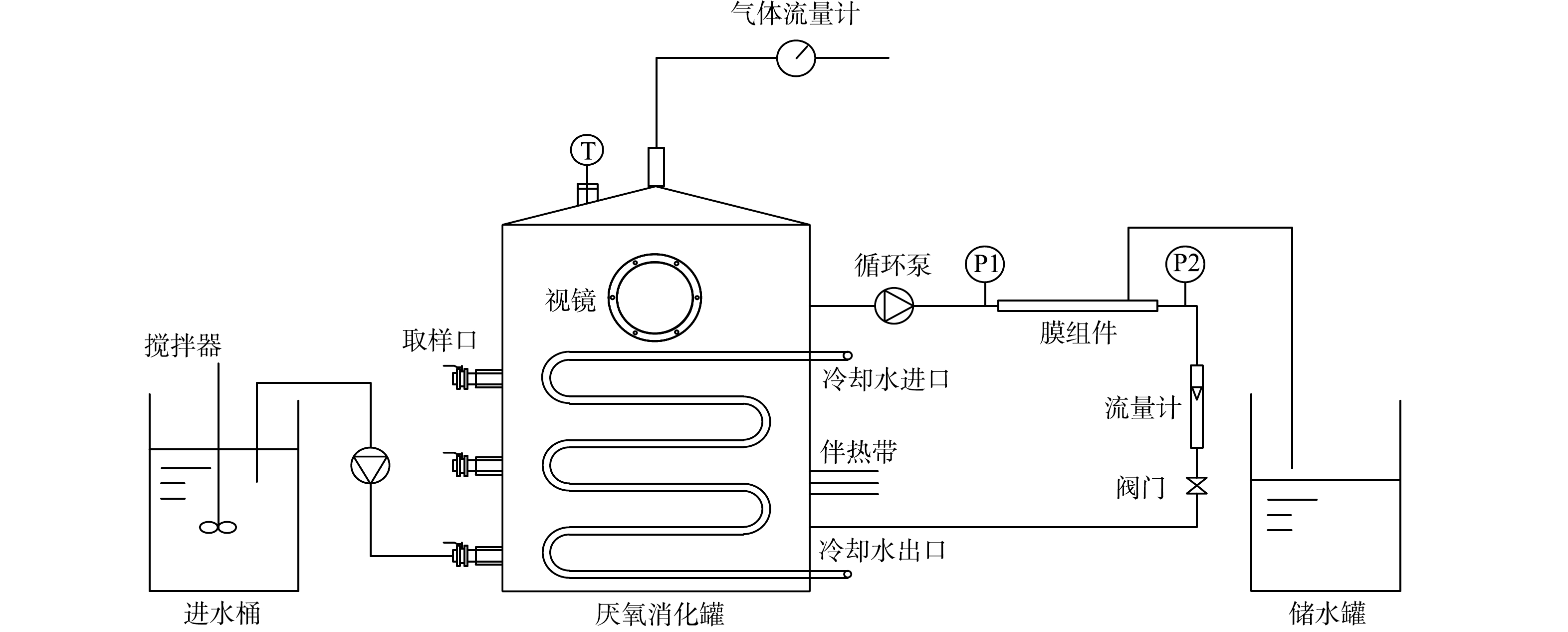
 下载:
下载:

